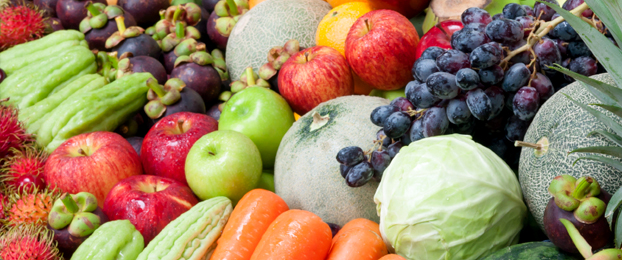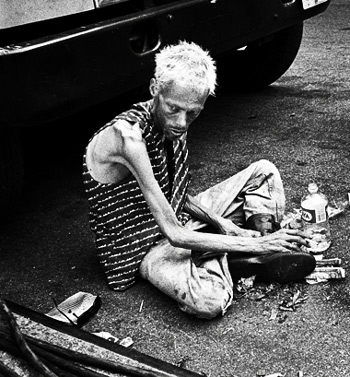
It has been 24 hours, and you still have no idea where you are. You’ve concluded that you’re lost. You may be lost for days, weeks, or even longer. Stay calm and decide what you need to do to survive. You need shelter, water, and food. You’ve already built an efficient shelter and located a water source, but you only have one Powerbar. Questions begin to race through your head. What happens to the body during starvation? How long can I survive without food? How do I increase survival time without food?
Starvation
Starvation occurs when the body is deprived of food (lack of fuel to support life). There are varying levels of starvation. The metabolic conditions that occur during starvation vary as starvation progresses.
When nutrient supply to the body is stopped, the body’s first priority is to provide glucose for the brain. In the early stages of starvation, glucose can be supplied by the breakdown of liver glycogen (stored glucose molecules). When blood levels of glucose drop, liver glycogen is broken down and shuttled to the bloodstream (Gropper 2000). The liver stores 100–110 grams of glycogen. After approximately 10–18 hours of food deprivation, liver glycogen is depleted (varies with activity levels).
Gluconeogenesis also contributes to glucose production. Gluconeogenesis is the generation of glucose from non-carbohydrate sources (e.g. lactate, pyruvate, most amino acids, glycerol, and propionate) (Hale 2005). The vast majority of gluconeogenesis takes place in the liver and, to a smaller extent, in the kidney.
In the early stages of starvation, amino acids derived from muscle protein are major contributors to gluconeogenesis. As starvation progresses and the body begins to rely more on free fatty acids and ketone bodies for fuel, protein breakdown decreases. Sparing valuable protein becomes the second priority of the body (Gropper 2000). Maintaining a specific level of protein is essential because proteins have many vital functions including the production of antibodies (to fight infection), hemoglobin (to carry oxygen to tissues), and enzymes (to assist in many life-sustaining reactions), and the ability to repair muscle, particularly of the heart.
As starvation continues, the body begins to decrease its metabolic rate, which decreases calorie expenditure. Tissues such as the heart and skeletal muscle switch from glucose to free fatty acids for fuel. Most tissues of the body can use free fatty acids for fuel. The brain is one of the few tissues that can’t. The liver produces and releases ketone bodies as a source of energy. Ketone bodies become a major fuel for the brain when they are produced in sufficient amounts. After approximately three weeks of starvation, up to 75 percent of the brain’s fuel is derived from ketone bodies. It’s a common myth that the brain can only use glucose for fuel. Let me repeat that. It isn’t true that the brain can only use glucose for fuel. In fact, ketogenic diets are often used for treatment with some neurodegenerative disorders. In the fed state, the brain uses only glucose. But to reiterate, this changes when starvation occurs. The body’s transition to the use of ketone bodies and fatty acids for fuel lessens the demands on its protein and glucose supply. After approximately three weeks of starvation, most of the body’s fuel demands are met by free fatty acids (92–93 percent).
Survival time without food
The major determinant of survival time without food is body fat levels. Another factor determining survival time is energy expenditure. In the 19th and early 20th century, it was thought that weight losses of 40–50 percent of initial body weight would result in death. The suggestion of a critical level of weight loss was soon dismissed as data revealed successful weight loss with percentages exceeding 50 percent (United Nations University). Successful weight losses of up to 76 percent of body weight have been reported in obese subjects. Weight loss percentages with lean individuals are significantly lower. Two important predictions concerning starvation are obese individuals will survive longer than lean individuals when deprived of food, and during starvation, obese individuals oxidize less protein than lean individuals.
How long can a human survive without food? It depends. An obese subject studied by Stuart and Fleming (1973) successfully fasted for 382 days. He entered the Guinness Book of World Records for the longest “total” fast (United Nations University). Other authors have reported successful fasts in obese subjects of 100–300 days. In general, survival time in lean subjects is less than 80 days. Newspaper reports indicate that in 1981, a Northern Ireland Fester died of starvation in 45 days. The decreased survival time was probably due to a previous gunshot wound to the hip. The body’s attempt to fight off illness increases calorie expenditure, thus speeding up the starvation process.
Individual responses to starvation vary. Much of what we know about starvation comes from studies on obese subjects. Much of the information found in these studies can’t be appropriately applied to lean individuals. Starvation-induced death is generally caused by a massive loss of bodily proteins. These losses cause decreases in vital organ size and function. Micronutrient deficiencies can also contribute to the critical effects of starvation that ultimately result in death.
Preventing starvation
Unless you’re very lean, ill, or lost for a prolonged period of time (without food), you probably will not die from starvation. It is good to prepare for the worst case scenario though. I’ve provided some tips below to ensure you don’t die of starvation in the wilderness.
Prevention tips
· Tell someone (or maybe a few people) where you’re going and when you will return.
· Be able to identify edible plants and prepare them for eating.
· Be prepared to hunt or fish for food (includes being familiar with primitive methods).
· Familiarize yourself with animal tracking techniques (assist in hunting and identifying the type of animals in the area).
· Don’t expend unnecessary amounts of energy (e.g. don’t use a bow and drill to start a fire if you have matches).
· Stay warm (increased shivering increase calorie expenditure).
References
- Gropper S (2000) The Biochemistry of Human Nutrition. 2nd edition. Wadsworth.
- Hale J (2005) The Carbohydrate Files. MaxCondition Publishing.
- United Nations University. Effect of Starvation and very low calorie diets on protein-energy interrelationships in lean and obese subjects. Accessed December 3, 2008 at:









